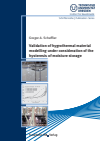Validation of hygrothermal material modelling under consideration of the hysteresis of moisture storage.
Abstract
The achievable accuracy of hygrothermal building component simulation is significantly dependent on the applied material functions. These functions are determined by the material modelling marking the connection between the basic storage and transport parameters which are obtained from basic measurements, and the storage and transport coefficients which are defined within the balance and flow equations. It is the aim of the present study to develop a flexible and widely applicable material model which is not restricted to the current level of the transport theory. Furthermore, limits and options of this model are to be validated by means of four building materials on the basis of special transient moisture profile measurements.
By the presented study, the material modelling has been decisively further developed, the set of basic measurement methods has been extended by a substantial experiment and the instantaneous profile measurement technique has been made applicable to Building Physics. Moreover, the influences of the process history and the process dynamics on the moisture transport and the resulting moisture profiles could be shown and proven. By that, not only a material model is now available which perfectly applies to the requirements of flexibility, applicability and extendibility. The obtained data provides also a powerful basis for further research and development.
Zusammenfassung
The achievable accuracy of hygrothermal building component simulation is significantly dependent on the applied material functions. These functions are determined by the material modelling marking the connection between the basic storage and transport parameters which are obtained from basic measurements, and the storage and transport coefficients which are defined within the balance and flow equations. It is the aim of the present study to develop a flexible and widely applicable material model which is not restricted to the current level of the transport theory. Furthermore, limits and options of this model are to be validated by means of four building materials on the basis of special transient moisture profile measurements.
By the presented study, the material modelling has been decisively further developed, the set of basic measurement methods has been extended by a substantial experiment and the instantaneous profile measurement technique has been made applicable to Building Physics. Moreover, the influences of the process history and the process dynamics on the moisture transport and the resulting moisture profiles could be shown and proven. By that, not only a material model is now available which perfectly applies to the requirements of flexibility, applicability and extendibility. The obtained data provides also a powerful basis for further research and development.
Schlagworte
Bauteil Wand Bauerhaltung Instandsetzung Wasserdampf Modellierung Materialmodell Charakterisierung Ingenieurmodell Feuchtigkeitstransport Flüssigkeit Universitäten Hochschulen Forscher- Kapitel Ausklappen | EinklappenSeiten
- 221–237 References 221–237

